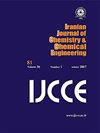The Modelling of the Urea Fertilizer Dissolution Process in Finite/Infinite Volumes of Water
IF 1
4区 工程技术
Q4 CHEMISTRY, MULTIDISCIPLINARY
Iranian Journal of Chemistry & Chemical Engineering-international English Edition
Pub Date : 2021-07-05
DOI:10.30492/IJCCE.2021.136188.4327
引用次数: 0
Abstract
This research aims to provide a model to investigate the impact of some parameters such as impeller speed, temperature, and solid concentration on mass transfer coefficient and the dissolution rate of urea fertilizer in the water. To study the effect of solid concentration two models are presented for finite and infinite volume fluids using mass balance. Then the urea-water mass transfer coefficient was calculated at various impeller speeds and temperatures by measuring the time to complete dissolution. To investigate the effect of impeller speed and turbulency on the mass transfer coefficient, the impeller speed and Reynolds number were set in a range of 10-50 [rpm] and 300-3000, respectively. The Schmidt number also was used to study the effect of temperature on mass transfer coefficient in the range of 5-25[°C]. The results show that in both finite and infinite fluid volumes, at a constant impeller speed with decreasing Schmidt number, and at a constant temperature with increasing Reynolds number, the mass transfer coefficient, and mass transfer rate increase. Furthermore, four models are presented for mass transfer coefficient in finite and infinite volume, that show the mass transfer coefficient and release rate in finite volume were lower than that of infinite volume at a constant impeller speed and temperature.尿素肥料在有限/无限体积水中溶解过程的模拟
本研究旨在建立一个模型,研究叶轮转速、温度、固体浓度等参数对尿素肥料在水中传质系数和溶解速率的影响。为了研究固体浓度的影响,用质量平衡的方法建立了有限体积和无限体积流体的两个模型。然后通过测定溶解完全时间,计算不同叶轮转速和温度下的尿素-水传质系数。为了研究叶轮转速和湍流度对传质系数的影响,将叶轮转速和雷诺数分别设置在10-50 [rpm]和300-3000范围内。采用Schmidt数研究了5 ~ 25[℃]范围内温度对传质系数的影响。结果表明:在有限流体体积和无限流体体积下,当叶轮转速恒定时,随着施密特数的减小,当叶轮温度恒定时,随着雷诺数的增大,传质系数和传质速率均增大;建立了有限和无限体积下的传质系数模型,表明在一定转速和温度条件下,有限体积下的传质系数和释放率均低于无限体积下的传质系数和释放率。
本文章由计算机程序翻译,如有差异,请以英文原文为准。
求助全文
约1分钟内获得全文
求助全文
来源期刊

Iranian Journal of Chemistry & Chemical Engineering-international English Edition
CHEMISTRY, MULTIDISCIPLINARY-ENGINEERING, CHEMICAL
CiteScore
2.80
自引率
22.20%
发文量
0
审稿时长
6-12 weeks
期刊介绍:
The aim of the Iranian Journal of Chemistry and Chemical Engineering is to foster the growth of educational, scientific and Industrial Research activities among chemists and chemical engineers and to provide a medium for mutual communication and relations between Iranian academia and the industry on the one hand, and the world the scientific community on the other.
 求助内容:
求助内容: 应助结果提醒方式:
应助结果提醒方式:


